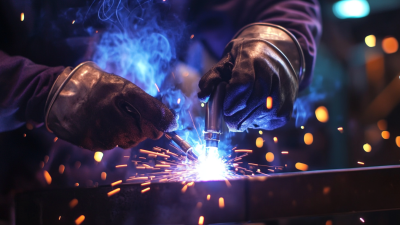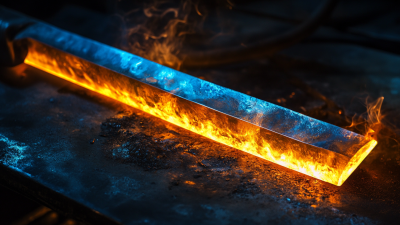In the rapidly evolving landscape of welding technology, mastering Smaw Stick Welding remains a fundamental skill for welders in 2023. According to the Bureau of Labor Statistics, the demand for skilled welders is projected to grow by 8% over the next decade, highlighting the critical need for refined techniques in traditional welding processes. Smaw Stick Welding, known for its versatility and portability, continues to be a preferred choice in various industries, from construction to manufacturing. With over 400 million welds performed annually in the United States alone, ensuring the safety and efficiency of welders is paramount. This article aims to equip aspiring and experienced welders alike with essential techniques and safety tips to harness the full potential of Smaw Stick Welding, ensuring compliance with industry standards and promoting a safer working environment.

 Stick welding, or Shielded Metal Arc Welding (SMAW), is a fundamental technique that continues to play a significant role in various industries, accounting for over 40% of welding applications globally, according to the American Welding Society. This process involves the use of a consumable electrode coated in flux; when an electric current passes through the rod, it melts the electrode and creates a protective gas, effectively shielding the molten weld pool from contaminants. Mastering the basics of SMAW is essential for any welder aiming to ensure structural integrity and safety in their work.
Stick welding, or Shielded Metal Arc Welding (SMAW), is a fundamental technique that continues to play a significant role in various industries, accounting for over 40% of welding applications globally, according to the American Welding Society. This process involves the use of a consumable electrode coated in flux; when an electric current passes through the rod, it melts the electrode and creates a protective gas, effectively shielding the molten weld pool from contaminants. Mastering the basics of SMAW is essential for any welder aiming to ensure structural integrity and safety in their work.
Understanding the parameters of stick welding, such as voltage, amperage, and travel speed, greatly impacts the quality of the weld. According to a report from Lincoln Electric, proper electrode selection based on metal type and thickness can improve penetration and reduce defects by up to 30%. Additionally, techniques like maintaining a consistent arc length and the appropriate angle of the electrode can further enhance the weld quality. With safety being a paramount concern—especially given that welding injuries are reported to be as high as 10% in the U.S. workforce—adhering to established safety standards and best practices, including personal protective equipment (PPE) usage, is crucial for maintaining a safe working environment for all welders.
Stick welding, or SMAW (Shielded Metal Arc Welding), remains a foundational skill for welders, especially in contexts where versatility and simplicity are essential. To master this technique effectively, it's crucial to focus on precision and control throughout the welding process. According to the American Welding Society, over 50% of all welding processes utilized in various industries involve stick welding due to its adaptability in diverse environments, ranging from construction to shipbuilding.
One key technique to enhance your stick welding effectiveness is maintaining the correct angle of attack between the electrode and the workpiece. A 15-30 degree angle can significantly improve your control over the arc, ensuring a more consistent weld bead. Moreover, steady travel speed is vital; industry data indicates that maintaining a speed of approximately 12 to 16 inches per minute achieves the best results for typical applications. Applying these techniques can not only improve the quality of your welds but also reduce the need for rework, a crucial factor in maintaining project timelines and budgets.
Safety is equally important while honing these skills. The National Institute for Occupational Safety and Health reports that welding-related incidents can be minimized by adhering to strict safety protocols. This includes proper personal protective equipment (PPE) like gloves, goggles, and protective clothing, as well as ensuring adequate ventilation. Incorporating these safety practices alongside effective techniques will lead to a more productive and safer welding experience.
When engaging in SMAW (Shielded Metal Arc Welding), prioritizing safety is crucial to ensure a secure working environment. Welders should start by wearing appropriate personal protective equipment (PPE), including a welding helmet with a proper shade lens, gloves, and flame-resistant clothing. These items safeguard against harmful UV radiation, sparks, and molten metal that can cause severe burns and eye injuries. Moreover, it's vital to have safety goggles and face shields available for additional protection, especially when grinding or cutting workpieces prior to welding.
Another essential measure is maintaining a clean and organized workspace. A clutter-free environment reduces the risk of accidents and improves efficiency. Adequate ventilation is also necessary to prevent the accumulation of harmful fumes produced during the welding process. Using fume extractors or working outdoors can help mitigate these hazards. Lastly, staying hydrated and taking regular breaks to avoid fatigue can significantly enhance focus and reduce the chances of mistakes, ensuring that safety remains a top priority throughout the welding process.

In mastering SMAW (Shielded Metal Arc Welding), understanding and avoiding common pitfalls is crucial for developing effective skills. One prevalent mistake is inadequate preparation of the workpiece. Cleanliness is vital; any contaminants like rust, oil, or paint can interfere with the weld quality, leading to weak joints. Welders should invest time in proper surface preparation, ensuring that their materials are well-cleaned and appropriately aligned before starting the welding process.
Another frequent error is ignoring the importance of correct electrode selection. Using the wrong electrode for the job can result in poor penetration and excessive spatter. Welders must familiarize themselves with different electrode types and their applications. Additionally, novice welders often overlook the significance of practice and technique. Rushing through the learning process can lead to bad habits, like improper arc length and speed, which compromise the integrity of the weld. By focusing on these key areas and implementing a thoughtful approach, welders can significantly improve their skills and safety in SMAW.
Proper maintenance and care of your welding equipment are crucial for ensuring its longevity and optimal performance. Regular cleaning and inspection can prevent the buildup of contaminants that could impair functionality. After each use, it's a good practice to wipe down your welding machine and cables to remove any slag or residue. This not only keeps your equipment in good working condition but also prevents safety hazards. Additionally, checking for any signs of wear, such as frayed cables or loose connections, allows for timely repairs, minimizing the risk of accidents.
Storing your equipment correctly is equally important. Welding machines should be kept in a dry, temperature-controlled environment to avoid damage from moisture or extreme temperatures. Additionally, use protective covers to shield your equipment from dust and debris. Keep your electrodes in a dry storage area, as moisture can lead to weld defects. By implementing these maintenance and care strategies, you can ensure that your SMAW stick welding equipment remains reliable and effective, allowing you to focus on perfecting your welding skills and safety practices.
| Technique | Description | Safety Tip | Maintenance |
|---|---|---|---|
| Stringer Bead | A continuous weld made using a straight motion. | Always wear a welding helmet with an appropriate shade. | Clean your welding electrodes regularly to prevent contamination. |
| Weave Pattern | A technique that moves the electrode in a zigzag or circular motion. | Ensure good ventilation to avoid inhaling harmful fumes. | Inspect cables and connections for wear and tear. |
| Tack Welding | A temporary weld to hold pieces in place before final welding. | Use appropriate gloves to protect your hands from heat. | Store electrodes in a dry place to prevent moisture uptake. |
| Fillet Weld | A joint made at an angle between two surfaces. | Always maintain a safe distance from sparks and spatter. | Check your welding machine settings before starting. |






